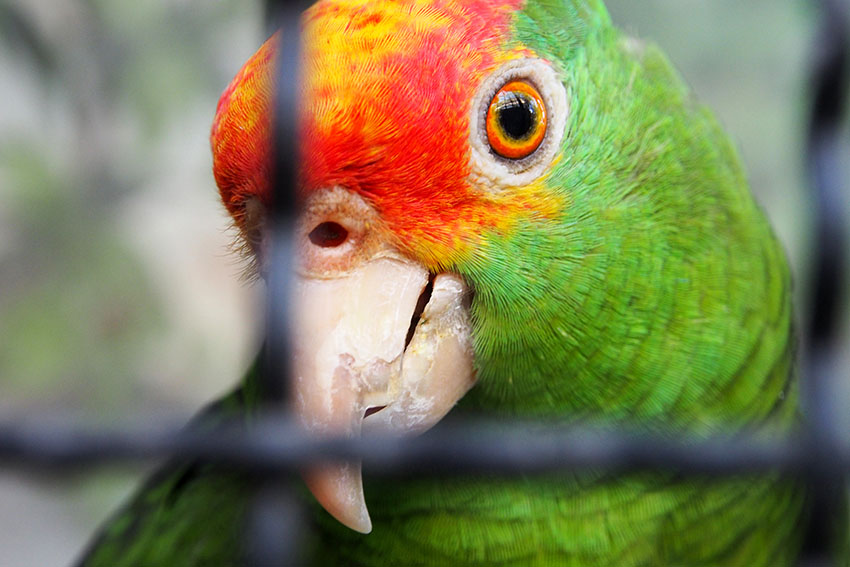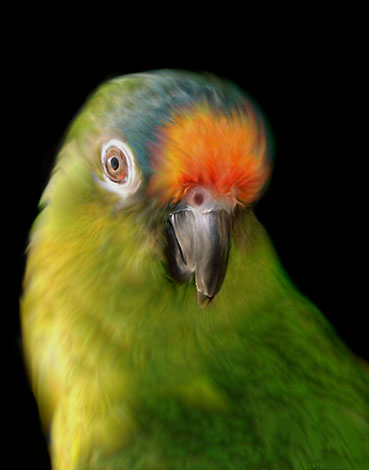The following signs indicate illness of some kind.
- An increase in lethargy. Unless asleep, not even the most timid of parrots will spend a long time silent and motionless. The first signs of lethargy might be when he shows a lack of interest in the things that usually stimulate him – you, new food, his mate, etc.
- Sleeping during the day. This could be due to external disturbances during the night. But if you can rule that out, the sleepiness will be a symptom of illness. One possibility is an infestation of feather mites, keeping him awake all night with their blood-sucking attentions.
- Fluffed up feathers. This means the bird is too cold, and indicates one of two things – either the cage or aviary is a bit chilly, or the parrot is unwell. A cold parrot may shiver too.
- Excessive squawking. If your bird is calling out in alarm constantly, he is in distress. There may be no visible symptom, but if you are sure that there is nothing in the vicinity to cause him great anxiety, you can conclude that he’s in pain.
- A change in perching behaviour. A bird who suddenly starts resting on the ground rather than a perch has either hurt a wing or is too weak to perch. Another, less drastic sign of problems is when a parrot who always sleeps while perched on one leg suddenly perches on two.
- A dirty vent – always a sign of wet or sticky droppings, which usually indicates health problems.
- Droppings. You will be familiar with the look of your parrot’s normal, healthy poo. Anything that deviates from the norm is a sign that something is wrong. The exception to this is a hen bird during nesting: her droppings may change appearance, and that’s not a sign of illness. (Note: some parrot pellet food contains colouring that dyes droppings. This is something to avoid, as it makes a healthy poo diagnosis much trickier.)
- Loose droppings. Sometimes a parrot will acquire a taste for a foodstuff that gives him diarrhoea if eaten in excess, so bear that in mind. If no such culinary culprit can be pinpointed, wet poo is a symptom of disease or parasites.
- Liquid in the droppings. This is normal - parrot’s excrete a small amount of liquid urine, but you might not even notice it, as most of the droppings will be falling onto sawdust or paper. Excess urine is a cause for concern, though. It may turn the droppings loose, as mentioned in the previous bullet, but will sometimes be visible as a wet ring around the solid matter. If there is more of this liquid than usual, talk to a vet.

Red-Crowned Amazon, showing what a healthy parrot should look like!
- Green. Green droppings in a bird whose poo is usually brown or black indicates that the parrot is not eating enough. This may be due to stress, or it may be that a young bird is malnourished due to poor diet. It could also be a symptom of an infection in the bird’s crop.
- Grey. If the poo is a uniform light grey or grey-brown, your parrot has a problem with his pancreas.
- Red. A dark red colour in the droppings is probably blood, and results from an intestinal problem (but always ask yourself if the bird has eaten cherries, red berries or beetroots – these will produce red patches in the poo, and that’s absolutely fine).
- Green and yellow. This is a symptom of liver disease, and the green colouring is caused by bile.

Peach-fronted Conure with healthy beak and cere
- Hot feet – this one requires your familiarity with the usual warmth of a parrot’s foot as he perches on your finger: hot feet is often a symptom of illness (kidney problems usually). Note, however, that an obese bird will have hotter feet too, and that one’s down to you – up his healthy food intake, and reduce the fatty seeds or snacks. A stressed or over-exercised bird will also have hot feet, so wait until he’s calmed down before making a judgement on his health.
- Cold feet – this symptom, if it results from illness, will be accompanied by listlessness, ruffled-up feathers and shivering. Note: a parrot fresh from the bath may have cold feet too, but that’s nothing to worry about.
- Swollen or sore eyes. If the area around the parrot’s eye is swollen, or if there is any eye discharge, it needs a vet’s intervention. The underlying problem could be one of a number of bacterial, viral or fungal infections.
- Sticky feathers on head or face. This may indicate an infection of the parrot’s crop. If this is the case he will be unable to eat and will die very quickly without a vet’s intervention.
- Blood on the feathers. This shows that the bird is wounded. He will be feeling weak, and may need antibiotics.
- Limping. The parrot has hurt his leg or foot, and will need to be checked to make sure nothing is broken.
- Overgrown beak or toenails. This is a sign of disease, often connected with liver problems.
- Deformed or misshapen beak. This is the work of burrowing mites, and needs treating if the parrot’s beak – and therefore life – is to be saved.
- Rapid breathing. This could be due to overheating; but it is also a symptom of illness. If the parrot has his beak open all the time, if you can hear any rasping or clicking sounds when he breathes, or if his tail twitches up and down with every breath, there are problems.
Comments
Teneisha, 28 February 2022
So my princess parrot developed 5 brown fluffy spikes on her nose. Looked at pictures of her species and none seem to have this group of brown spikes. I cannot find anything about these either
Gul, 11 June 2021
My alexandarine parrot baby is half covered, a week ago i purchased it, at home i noticed that it has linings in his feathers and a bit weak, it was very demanding for food, two days before i over fed him grinded chick peas and in morning barley flakes, from that the parrot seems very dull, the food in crop remained undigested for one day, know the parrot doesn,t demand for feed, screams strangely, feathers are loose, but know it digests food and the color of dropping one day before was pea green ( may be due to stomach medicine) know the poo color is normal, but the bird is too weak and it is very light in weight, please help me as here there isn,t any avian vetnaranian
Amit, 24 March 2020
My alexandarian parrot, since he was four week old he was having shivering problem, than it comes up with rapid breathing, increased when eat too much, now he is eating too much. He is 3 months two weeks old. Not well growned, feather is coming tii slow. Yet coming, once diagnosed with antibiotic amoxcylin for seven days, no response. No vet here at my place, helpless.